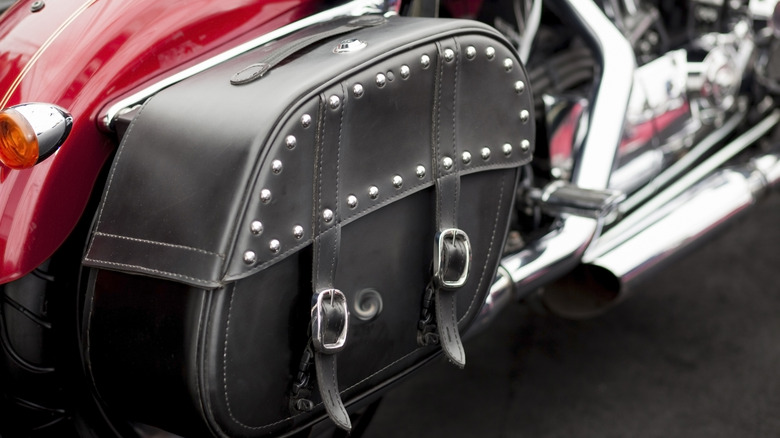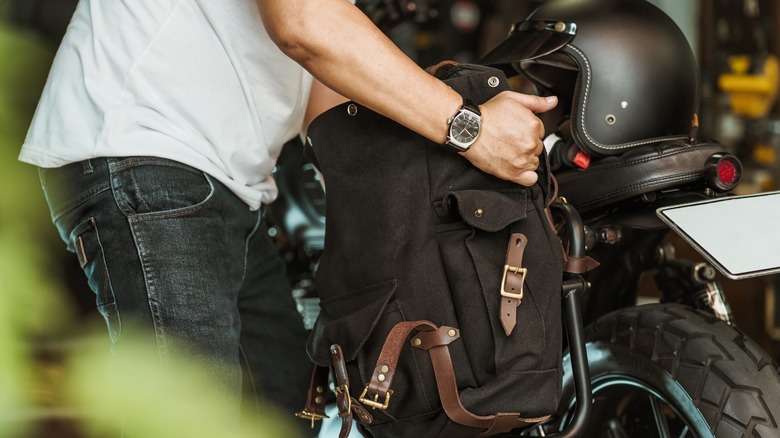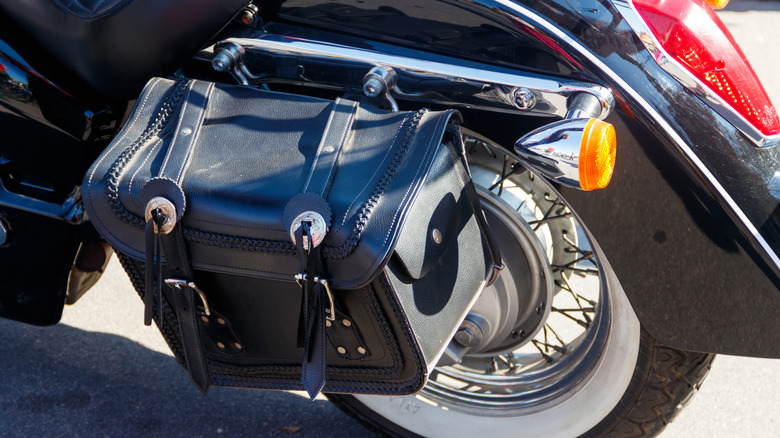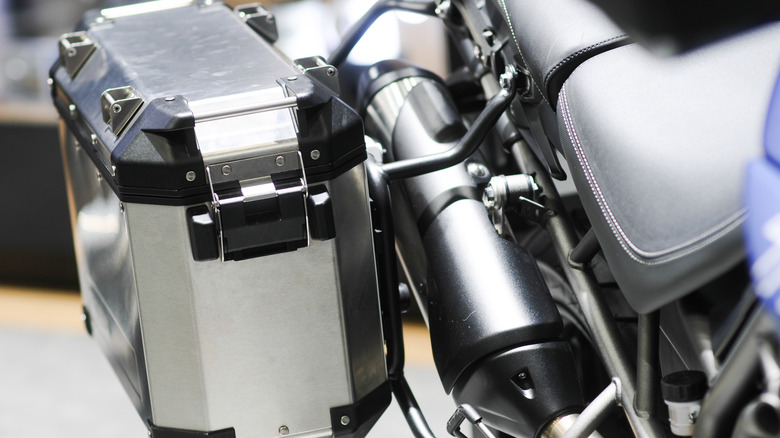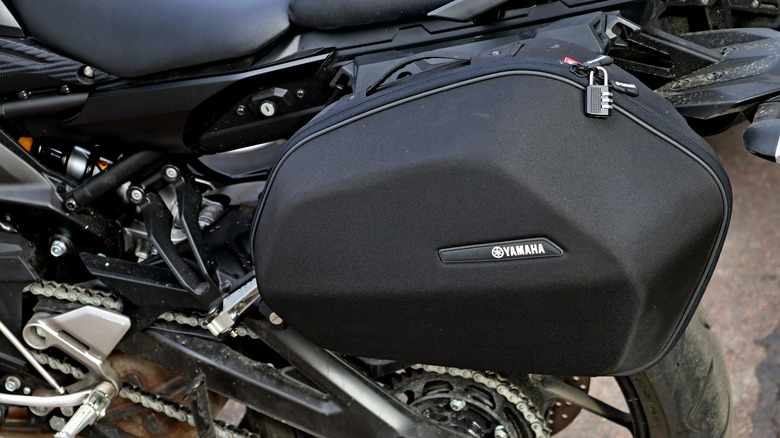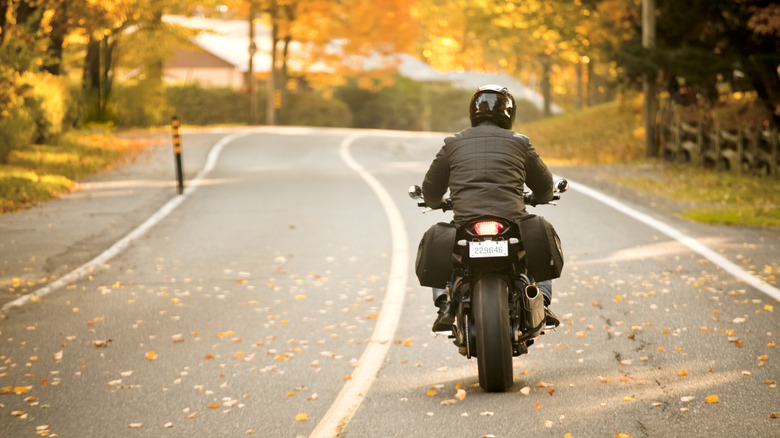5 Things You Need To Consider Before Buying Motorcycle Saddlebags
We may receive a commission on purchases made from links.
Compared to other means of conveyance, a motorcycle isn't exactly flush with ways to carry your personal belongings. If your bike doesn't have a dedicated storage compartment or a passenger car attached, then your only real option for carrying stuff is wearing a backpack, which can be a little tiring on a long-haul drive without some extra weight-alleviating tricks. Fortunately, there is a way to add some extra carrying capacity to your motorcycle, one inspired by the frontier travelers of old: saddlebags.
Much like the hearty bags hanging from the saddles of pioneer horses, motorcycle saddlebags are designed to latch onto both sides of the rear of the motorcycle seat. This adds a healthy amount of easily-accessible storage space, not to mention a bit of western flair to your ride's style. Saddlebags are readily available from a variety of manufacturers at your local motorsports shop, though before you run out to buy the first pair that catches your eye, you might want to make a checklist. There are some factors you should consider in order to find the perfect pair of saddlebags for you and your ride.
Can your motorcycle handle saddlebags?
The first and most important question is whether or not your motorcycle is actually ready to rock a pair of saddlebags. Saddlebags are often designed with particular motorcycle models in mind, but you should definitely double-check that your particular ride can hold them, just in case.
Saddlebags are meant to be either attached or draped over the rear of the motorcycle seat. The catch here is that there's often a lot already going on in that particular area, such as turn signals and exhaust pipes. Depending on the kind of motorcycle you're using, you might be able to alter the positions of the turn signals to make a little extra room, but for the exhaust pipes, you're going to want at least two to four inches of clearance between them and a bag. Fair warning, if your saddlebags get damaged by the exhaust pipes, that's usually not covered by a warranty replacement.
As we mentioned, saddlebags typically come in throw-over and bolt-down designs. If your motorcycle can facilitate it, and if you don't mind some light modification, a bolt-down bag is much more secure. If your bike's particular shape doesn't make that kind of modification easy, or if you just don't want to do it, a throw-over bag will work. Just be aware that throw-over bags may jostle around more in transit, since they're not physically bolted down.
What size do you want your saddlebags?
If you're reasonably certain your motorcycle can handle saddlebags, then the next thing to consider is how large you want your saddlebags to be. Saddlebags come in a fairly wide range of sizes, both to fit a variety of motorcycle body types and to meet your needs for carrying capacity. Think carefully about what you plan on using your saddlebags to carry. Are you going to be doing some light grocery shopping? Carrying supplies for a long-haul trip? If you know you're going to be carrying a large amount of stuff on a regular basis, then naturally, you'll want a larger pair of saddlebags. If you only need a convenient nook to stash some assorted odds and ends, a smaller pair might be better.
Choosing saddlebag size isn't just about storage capacity, though. The most important thing is to pick a pair of bags that are proportionally sized to the rest of your motorcycle. If your ride is small in stature, then a gigantic pair of saddlebags hanging off the back will not only make it look kind of doofy, but the weight and size could subtly throw off the balance of the body, impacting your ability to drive safely.
What should your saddlebags be made of?
In addition to how physically large your motorcycle saddlebags are, you should also spare a thought to what they're made of. Particular materials offer different levels of protection against the elements, not to mention the occasional scuff.
The most popular choice for saddlebags is good old fashioned leather, just like the cowboys had. Classic leather is an excellent choice for a saddlebag; it's naturally resilient, lightweight, and besides everything, it looks quite stylish. However, as with a leather motorcycle seat, getting leather saddlebags does come with certain responsibilities. Just like other tips and tricks to keep your motorcycle looking brand new, you need to regularly care for and maintain your leather with proper cleaning and conditioning, or else it could lose its protective ability and luster. You may be able to offset this by using imitation leather saddlebags, though whether or not you suffer a trade-off in quality depends entirely on what the imitation leather is actually made of.
Besides leather, you could also opt for hard material saddlebags. Thicker, heavier-duty saddlebags made of materials like fiberglass, aluminum, or plastic provide a comparable level of protection to leather without requiring as much upkeep. However, harder materials are also often heavier in weight, which could have knock-on effects on your motorcycle's handling if they're too large or your bike isn't powerful enough.
What extra features can saddlebags have?
Since your saddlebags are making themselves at home on your motorcycle, it's only right that they provide a little bit of extra utility. While most saddlebags are designed to just carry things, certain higher-end saddlebags may have a few extra features to sweeten the pot.
The first, and perhaps most important extra feature to consider on saddlebags is a security lock. Simpler saddlebags may only close with ordinary belt buckles or zippers. That's certainly enough to keep the flap closed on the road, but it does nothing to prevent a hoodlum from popping them open and rifling through your stuff at a rest stop. This is why you may want a saddlebag with either a key or combination locking mechanism, something that nobody can open without your permission. It is possible to add a lock to a saddlebag but it takes a bit of handiwork, so one with a built-in lock is preferable.
Additionally, some saddlebags, particularly those made of harder materials, may have built-in tail lights to better illuminate the bike's altered body shape at night. They can even have turn signals that can be wired into your bike's system. Similarly to locks, these can be added to saddlebags after the fact through standalone LED strips, but having them built-in is a time saver.
How much do saddlebags cost?
So, you've got your bike all measured up and you know exactly how much hauling you're looking to do in your potential saddlebags. That just leaves one last crucial piece of the puzzle: how much is all of this going to run you? The answer to that depends on the size, complexity, and most of all, branding of the saddlebags you've got your eyes on.
As with most things, name brands mean larger price tags. For example, if you wanted to get a pair of Harley-Davidson branded saddlebags for a simple cruising motorcycle for beginners, that's going to set you back $295 at the bare minimum. That's for imitation leather, by the way; if you want real leather with Harley branding, the price shoots up as high as $950.
However, if you're not bothered by the big names, you may be able to save a bit of cash by opting for bags from smaller brands. Saddlebag manufacturer Viking Bags, for instance, has medium-sized imitation leather softail saddlebags for $269.99. You could also opt for generic bags available on Amazon for as low as $114.99. Just remember that some products may not come with support or warranties in the event of damage.
